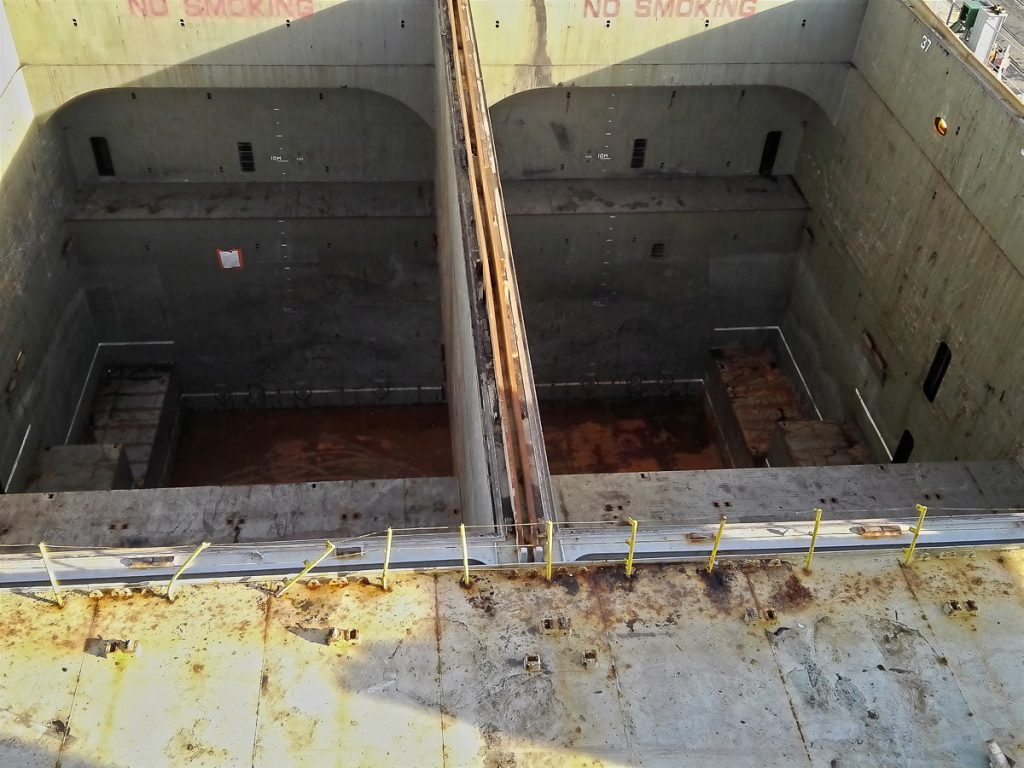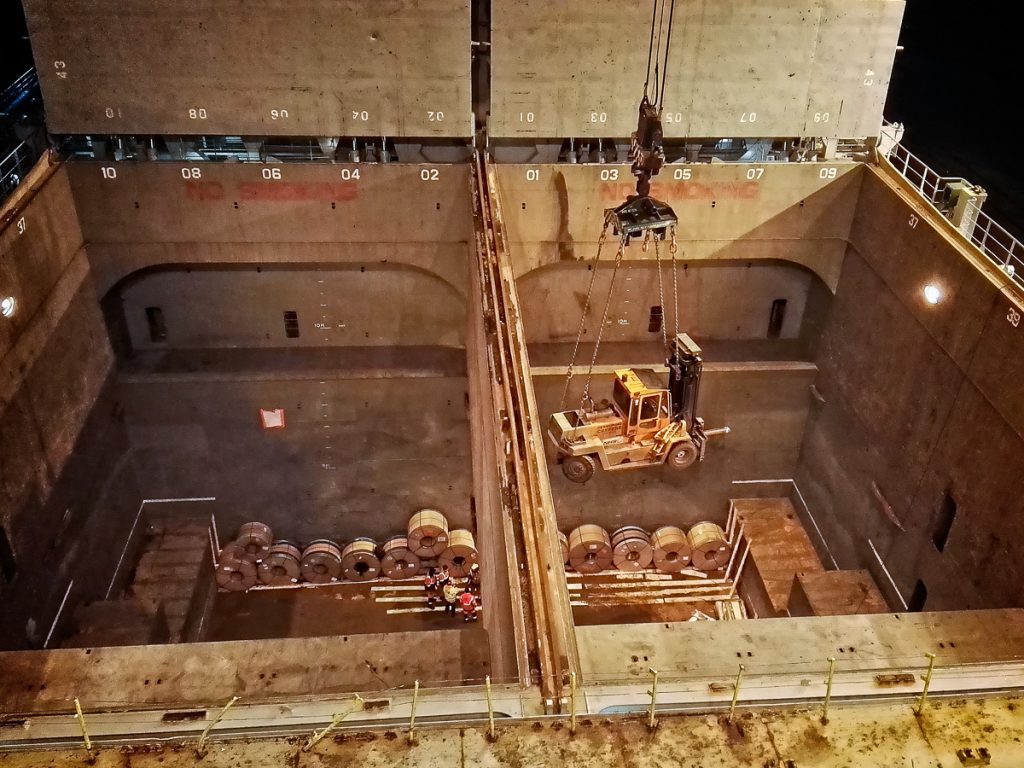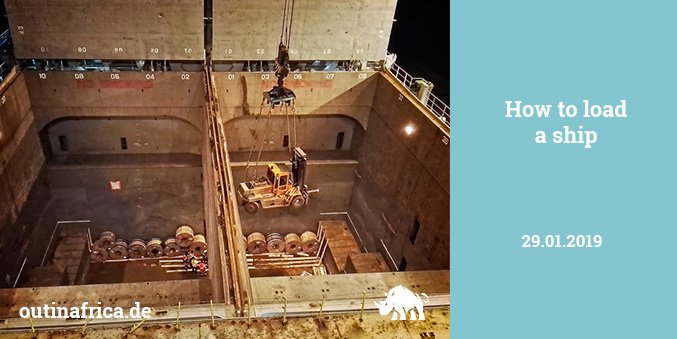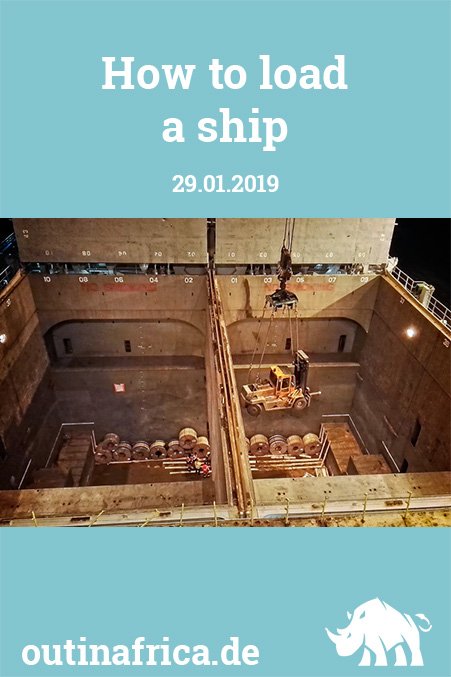This post is also available in:  Deutsch (German)
Deutsch (German)
Today I donned my last clean pair of underpants. I have to get active and do the laundry. There is a washing machine on the D-deck for the officers that we passengers are allowed to use. There is also a laundry with washing machines and dryers at the bottom level. Since these machines are often used, I wash at the officers’ room and then bring the stuff down to dry it.
Now everything is washed, dried, folded and cleared away.
A tip for those who want to go on a freighter voyage: Take non-iron laundry with you! The dryer has no crease protection. There are an ironing board and iron, but I don’t feel like ironing. I still have enough pressed outerwear with me. Underwear and pyjamas don’t have to be done.
At lunch, I have an interesting conversation with the cargo agent of the shipping company in Antwerp. The planning of the loading of the ship starts four weeks in advance. Using paper, pens and calculators, he can make a rough plan of what is to go where. Three factors are essential for this: the size of the object, the weight and the order of the ports to be served.
Size is about the space the cargo will occupy. What fits where? When you take a massive object with you, you have to decide what fits next to it. It’s like oversized 3D Tetris.
When it comes to weight, the ship must be balanced. Not all heavy items should be loaded only at the front or rear or only to the right or left. In the end, the ship must lie steady and straight in the water.
The order of the harbours determines what is loaded at the top and what at the bottom. The cargo for Walvis Bay must be at the top because this is the first port to be called. You don’t want to empty a whole ship to take out a container from the bottom.
The basis of all this, as always and everywhere in our universe, is physics. The strength of steel, the density of water, gravity, lift, leverage, waves, balance, fuel combustion, engine power, vehicle speed, resistance to wind, water and currents; these things and many more set the ship’s limits. If these limits are exceeded, in the mildest case the voyage is inefficient, in the moderate case something breaks and in the worst case, the ship sinks. Of course, no boundary of physics should be crossed at all. On the other hand, they should not be undercut too far.
As always in shipping, it’s about money. If the limits of physics are crossed, it becomes costly; if it falls too far below them, the profit is not big enough. The cargo agent’s job is to find the golden mean.
In the next round, the cargo agent discusses the rough planning with the chief officer on the ship and the whole thing is then refined by computer.
In the end, the cargo agent knows down to the centimetre where what is going, how long it will take to load, and how many people, cranes, forklifts and other equipment are needed. Depending on the ship’s schedule, night and weekend work is also involved. For the Bright Sky, he has 20 crew groups who are active during loading.
Planning starts four weeks in advance, but things can change at very short notice. The cargo agent received a call last Friday afternoon about this shipment. Twenty tons of steel plates should come along. The cargo agent had to sit in front of the computer all weekend figuring out where to get the plates stored. On Monday morning, there was another phone call that the customer had changed his mind and would send the steel plates with the next ship. A weekend’s work for nothing.
The loading itself is a matter of every minute. If a crew has to wait a quarter of an hour because something is not there or the hold of the ship has not been opened in time, it costs 500 € for doing nothing.
The alternative is containers. There the only question is whether the red container should come above or below the blue container. Container ships are very easy to load. They are efficient. Our cargo agent in Antwerp hates them. That is no longer shipping, that is extended logistics. He doesn’t want to work with container ships.
Unfortunately, container ships are increasingly taking over from multi-purpose freighters. Bulk cargo can also be shipped in containers. And, in the shipping crisis, container ships have also taken along large machines that did not fit into containers. But securing this cargo in a container ship is very complicated, and the load usually arrived damaged at its destination.
With container ships, every minute counts. While the loading of vessels like the Bright Sky is calculated in periods of days, the loading of container ships is calculated in hours and minutes. They have to be at the container terminal at a particular time; otherwise, they lose their berth. This urgency is one reason why MSC Zoe lost 270 containers in the North Sea a few days ago. Despite the storm, the ship was sailing much too fast because it had to meet a deadline.
We are also talking about the eco-friendliness of shipping. The cargo agent is still young, perhaps 35 years old, and very open-minded about the environment. He finds it sad that ships are often regarded as dirty. The fact is that shipping is the most energy-efficient way of transporting goods. Let us compare the fuel consumption of a ship with that of a lorry. The fuel a freighter needs to transport cargo from Hamburg to Shanghai is consumed by trucks carrying the same load on the way from Hamburg to Munich. The transport of goods by air is even worse. Yes, ships are slower than trucks and planes, but in the end, they are the best for the environment.
It is also by no means the case that ships always pollute the air. The International Maritime Organisation is constantly tightening up the emission regulations for ships. These better emission values can be achieved in one of two ways: The fuel must be cleaner, or the vessels must install filter systems for the exhaust gases. In the long term, clean fuel is the cheaper alternative, but it is already foreseeable that this fuel will not be available everywhere. In Europe it is possible to supply the cleaner fuel, but not in Asia or Africa – and if so for five times the price. As a result, the ships have to be re-equipped at a high price.
So before we complain about dirty ships, according to the cargo agent, we should first consider whether we need fruit from South America or the latest gadgets from Alibaba by air freight. Why must apples be imported from all over the world when farmers in Belgium also offer apples but are outbid by cheap goods from other countries? Do we really need strawberries around Christmas time?
Ships are switching to slow transport. They go a few knots slower and save 40 to 50 per cent fuel. That is good for the environment and cheaper for the shipping company, but it conflicts with the desire of consumers to have everything immediately available.
It is an enjoyable conversation with the man who shows that he loves his work. When the ship leaves, his job is done, and he can celebrate for a moment before planning the next freighter’s cargo.
He tells me a few more facts about the Bright Sky: The ship itself weighs 60,000 tons. 32,000 tons can be loaded. The displacement of the vessel, when fully loaded is 54,000 tons. Water is 1000 times denser than air. This explains why a passenger ship with 50,000 hp travels at 30 km/h and a Bugatti with 1200 hp at 400 km/h. You have to take the water-resistance into account. If you divide the 50 000 hp of the ship by 1000, you get 50 hp. If the weight of the vessel is now taken into account, you have to have a truck with 50 hp in mind.

In the afternoon, the cargo hold in front of my window is completely emptied. It is 15 m deep. I calculate that our future house in Namibia would fit 12 times into one of the two halves. Fifty long containers could be loaded there. You have to experience these dimensions for yourself. They do not show on photos, and one’s imagination is not enough.

Pierre returns to the ship at dinner time. He talks to the captain about his curiosity (which I share to the same extent) and makes a remark that makes me think. Pierre says that he is interested in all shipping, but that knowledge alone is not enough for him. If he wants to know how big a ship is, he can google it or read books about seafaring. But that is not enough for him. He doesn’t just want to know it; he also wants to experience it.
Experience is more than knowledge. As a librarian, I reflexively resort to any sources of information when I have a question. When I find the answer, I know more. That is already an enrichment. But it is even more if I experience it.
Let’s take this ship. I can read that it is 200 m long and 30 m wide and weighs 92,000 tons when fully loaded. But today I have noticed that if I pass these facts on to my WhatsApp groups and even illustrate them with photos, the people who are not here still have no idea how big the Bright Sky is. You have to experience it. Only then do you really know. And if you then compare our ship with a container giant, you can only understand the real relations if you have experienced both ships.
I make a resolution for the future: If I can choose between experience and knowledge, I want to experience.
I have thought about this resolution again and again during the journey. I had planned to take a lot of time to write our blog and to acquire even more knowledge about things like photo and video editing. But after Pierre’s explanation, I said to myself: Experience the ship! Experience the trip! Time to write and edit pictures comes after the tour. Now I am on the vessel. Be all there in the here and now on this freighter. I will perhaps never again make a journey with a ship, so experience it consciously.
Would you like to see an overview of all articles about my journey on the cargo ship Bright Sky? Click here for a table of contents.



Leave a Reply